Morski start made in China 05.06. o 04:06:01 z barki zakotwiczonej na Morzu Żółtym w lokalizacji 34,90ºN, 121,19ºE wystrzelona została RN
CZ-11 WEY, która wyniosła na orbitę siedem satelitów: dwa Jilin-1, CAS-6A i 6B, Bufeng-1A i 1B i ?.
http://lk.astronautilus.pl/n190601.htm#03Pierwszy morski start CZ-11 BY KRZYSZTOF KANAWKA ON 5 CZERWCA 2019
 Start CZ-11 - 05.06.2019 / Credits - CCTV
Start CZ-11 - 05.06.2019 / Credits - CCTVPiątego czerwca chińska rakieta CZ-11 wykonała pierwszy start z platformy morskiej.
Rakieta CZ-11 wystarowała 5 czerwca 2019 roku o godzinie 06:06 CEST. Start odbył się z platformy morskiej, około 600 km od lądu na Morzu Żółtym. Lot tej rakiety przebiegł prawidłowo i na orbicie znalazło się łącznie siedem satelitów.
Morski start CZ-11 – 05.06.2019 / Credits – CCTV
Był to siódmy start CZ-11. Dotychczas starty tej rakiety odbywały się z kosmodromu Jiuquan. Starty z morza mają kilka zalet, w szczególności w przypadku Chin. Dotychczasowe starty z tego państwa w wielu przypadkach skutkują przelotem rakiety nad terenami zamieszkałymi. Dość często zdarza się upadek pierwszego stopnia na tereny zabudowane lub drogi. Niektóre z chińskich rakiet wciąż używają toksycznych paliw, co oczywiście nie pozostaje bez wpływu na lokalną społeczność. Dlatego też wprowadzenie morskiej wersji rakiety CZ-11 wydaje się być jedną z prób zminimalizowania problemu upadku pierwszych stopni rakiet na ląd.
Był to pierwszy start rakiety z morza od maja 2014 roku. Wówczas po raz ostatni
wystartowała rakieta Zenit-3SL w ramach usługi Sea Launch.
(PFA, NSF, GP)
https://kosmonauta.net/2019/06/pierwszy-morski-start-cz-11/China completes first offshore rocket launchSource: Xinhua| 2019-06-05 14:09:35|Editor: mingmei
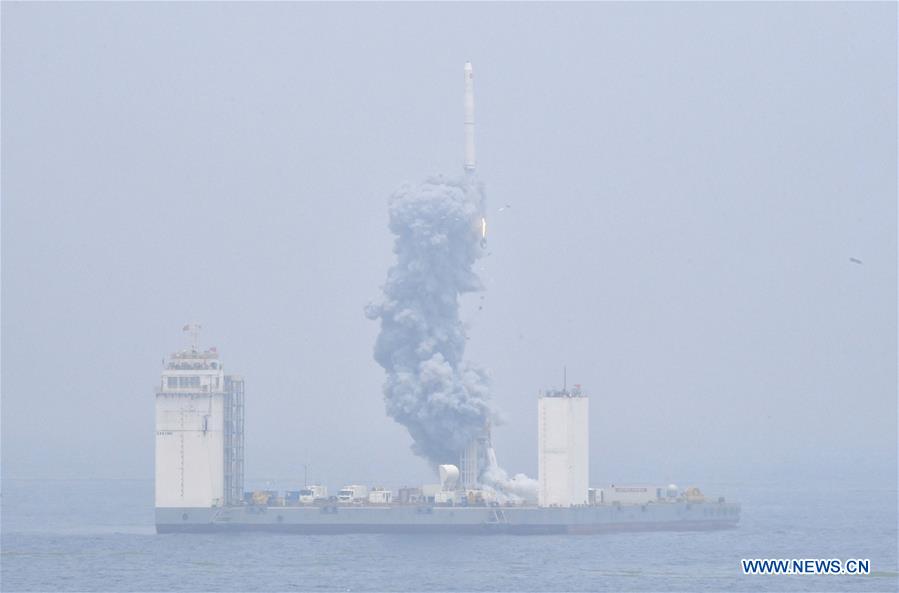
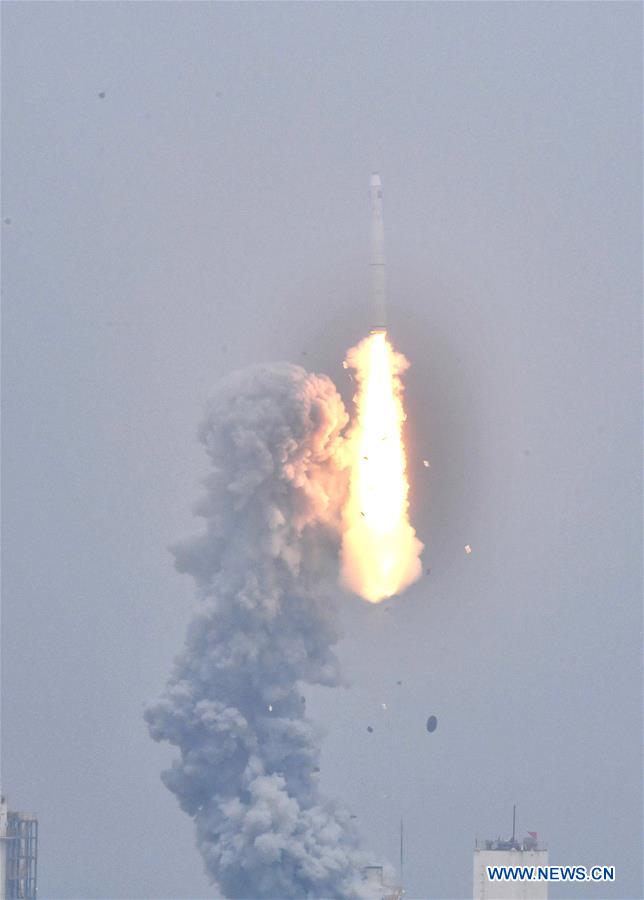
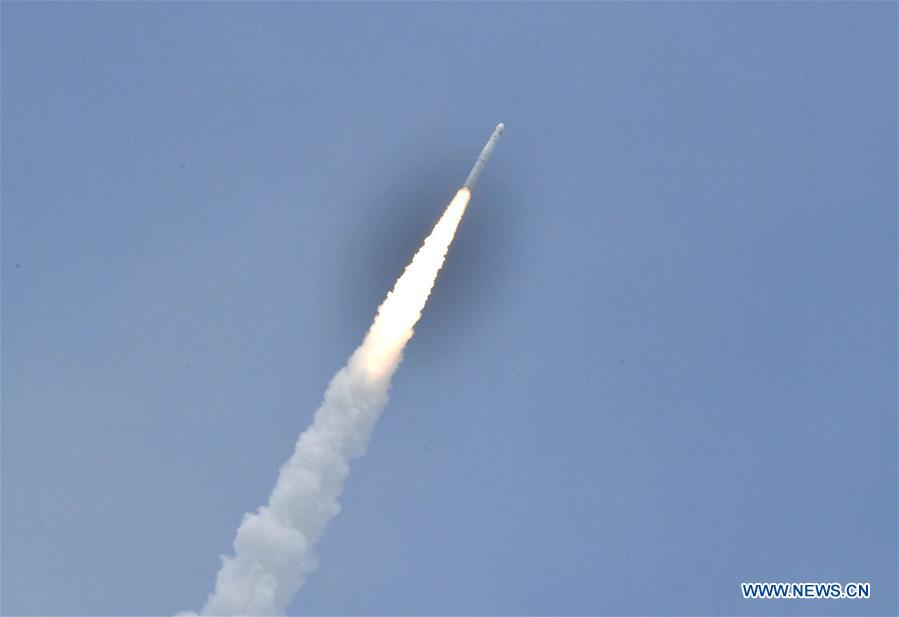 A Long March-11 solid propellant carrier rocket is launched from a mobile launch platform in the Yellow Sea off east China's Shangdong Province, June 5, 2019. China successfully launched a rocket from a mobile launch platform in the Yellow Sea off Shandong Province on Wednesday, sending two technology experiment satellites and five commercial satellites into space. A Long March-11 solid propellant carrier rocket blasted off at 12:06 p.m. from the mobile platform. It is China's first space launch from a sea-based platform and the 306th mission of the Long March carrier rocket series. (Xinhua/Zhu Zheng)
A Long March-11 solid propellant carrier rocket is launched from a mobile launch platform in the Yellow Sea off east China's Shangdong Province, June 5, 2019. China successfully launched a rocket from a mobile launch platform in the Yellow Sea off Shandong Province on Wednesday, sending two technology experiment satellites and five commercial satellites into space. A Long March-11 solid propellant carrier rocket blasted off at 12:06 p.m. from the mobile platform. It is China's first space launch from a sea-based platform and the 306th mission of the Long March carrier rocket series. (Xinhua/Zhu Zheng)QINGDAO, June 5 (Xinhua) -- China successfully launched a rocket from a mobile launch platform in the Yellow Sea off Shandong Province on Wednesday, sending two technology experiment satellites and five commercial satellites into space.
A Long March-11 solid propellant carrier rocket blasted off at 12:06 p.m. from the mobile platform. It is China's first space launch from a sea-based platform and the 306th mission of the Long March carrier rocket series.
The rocket is also named "CZ-11 WEY" under an agreement between the China Academy of Launch Vehicle Technology, China Space Foundation and a Chinese automobile producer.
Launching a carrier rocket from an ocean-based platform has many advantages over a land launch.
The closer to the equator a rocket launch can get, the greater the speed boost it will receive. It reduces the amount of energy required to get into space and means that less fuel is required.
The launch site is flexible and falling rocket remains pose less danger. Using civilian ships to launch rockets at sea would lower launch costs and give it a commercial edge.
The seaborne launch technology will meet the growing launch demand of low inclination satellites and help China provide launch services for countries participating in the Belt and Road Initiative, according to experts.
The two satellites, developed by China Academy of Space Technology, are expected to step up all-weather monitoring of ocean wind fields and improve typhoon monitoring and accuracy of the weather forecast in China.
Among the five commercial satellites, the two satellites, developed by China Electronics Technology Group Corporation, are China's first small satellite system based on Ka-band.
The Long March-11, developed by China Academy of Launch Vehicle Technology, is the only rocket using solid propellants among China's new generation carrier rockets. It is mainly used to carry small satellites and can take multiple satellites into orbit at the same time.
http://www.xinhuanet.com/english/2019-06/05/c_138118602.htmChina gains new flexible launch capabilities with first sea launchby Andrew Jones — June 5, 2019
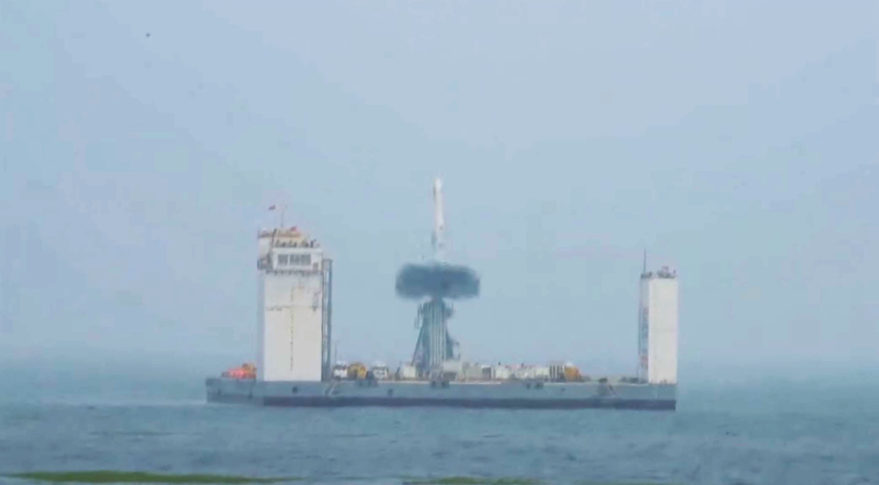 Liftoff of the Long March 11 from a mobile platform in the Yellow Sea, June 5, 2019. Credit: CCTV/framegrab
Liftoff of the Long March 11 from a mobile platform in the Yellow Sea, June 5, 2019. Credit: CCTV/framegrabHELSINKI — China successfully launched a Long March 11 solid rocket from a sea launch platform Wednesday, bringing its burgeoning space program new, flexible launch capabilities.
The Long March 11 solid propellant light launch vehicle
lifted off from a mobile launch platform in the Yellow Sea at 12:06 a.m. Eastern, with launch success declared within half an hour.
The 20.8-meter-long, 2-meter-diameter and 58-metric-ton four-stage rocket lifted seven satellites into 600-kilometer altitude orbits.
The satellites included Bufeng-1A and B, designed by the China Academy of Space Technology to monitor ocean wind fields and improve typhoon monitoring, Xiaoxiang-1-04, a small satellite developed by Changsha-based private firm Spacety, an experimental communications satellite, Tianqi-3, developed by Guodian Gaoke, and two ‘Tianxiang’ Ka-band communications test satellites for the China Electronic Technology Group.
The final payload, the Jilin-1 03A high resolution optical satellite for Changguang Satellite Technology Co. Ltd., a commercial offshoot of the state-owned Changchun Institute of Optics, Fine Mechanics and Physics under the Chinese Academy of Sciences, has a mass of 42 kilograms. The company’s first optical satellites, launched in October 2015, had masses of 420 kilograms.
The mission was the first sea-based launch globally since multinational spacecraft launch service provider Sea Launch in May 2014.
Leena Pivovarova, an analyst at consulting firm Northern Sky Research, told SpaceNews that the move fits into wider developments, with the small launch industry as a whole trending toward offering more flexible launch solutions.
“We are seeing several emerging launch actors developing responsive launch capabilities in different ways, such as designing mobile spaceports or remote mission ops centers,” Pivovarova said.
“For example, players like Virgin Orbit/VoxSpace will not be tied to a specific runway, and will be able to offer launches to any orbit and destination without the traditional launch constraints. The sea launch of Long March 11 will demonstrate a similar mobility factor, specifically being able to hit any orbit without being constrained to a set geographic area.”
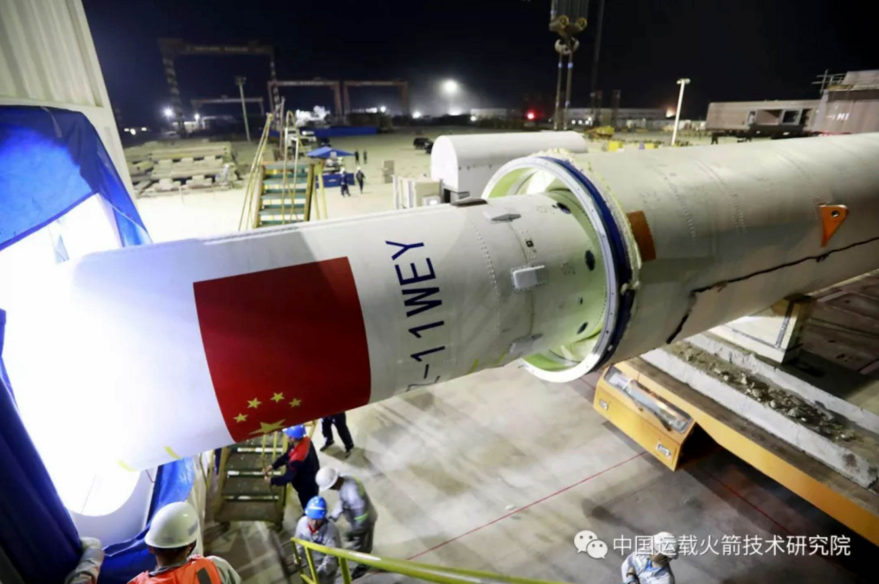 Preparations for the Long March 11 sea launch. Credit: CALT
Preparations for the Long March 11 sea launch. Credit: CALTSea launches also allow low-inclination launches, with the greater rotational speed of the Earth near the equator meaning lower fuel requirements or higher payload capability.
Rapid response, risk reductionThe newly developed capability also provides benefits to range of space sectors.
“Rapid response capabilities are important to the commercial industry, but are especially significant to the government and defense sector. The mobility factor enables quick and somewhat stealthy launches, which is of special interest to governments’ strategic interests,” Pivovarova notes.
In China’s case, sea launch capabilities could help mitigate safety risks to its civilian population. Three of China’s four national launch centers are located deep inland, meaning rocket stages fall to ground rather than the seas, and often threaten populated areas. Evacuations of areas within rocket stage drop zones also raise the economic costs of launch.
Further innovations and technologies such as vertical takeoff, vertical landing and parafoils are being developed by China’s main space contractor to reduce risk, while emerging private companies may also eventually offer solutions.
The rocket for the Wednesday launch was named “CZ-11 WEY” (‘CZ’ standing for Changzheng or ‘Long March’), following an agreement between the China Academy of Launch Vehicle Technology, the launch vehicle developer, the China Space Foundation and a Chinese automobile producer Great Wall Motors, which owns the WEY brand.
The launch was the seventh for the Long March 11, the only solid propellant rocket of the series, and the 306th Long March launch overall. It was the tenth launch in 2019 for China, which is planning more than 30 launches this year. The country’s previous launch, on May 22 from Taiyuan,
ended in failure.
https://spacenews.com/china-gains-new-flexible-launch-capabilities-with-first-sea-launch/China’s first sea launch declared a successJune 5, 2019 Stephen Clark
(...) Chinese officials declared the launch a success, according to state media reports. The 68-foot-tall (20.8-meter) rocket was expected to deliver its seven satellite payloads into orbit several hundred miles above Earth.
As of Wednesday afternoon, U.S. time, the U.S. military’s catalog of space objects had not yet registered any new satellites attributed to the Long March 11 launch.
Wednesday’s mission was China’s first space launch from an ocean-going mobile platform. The sea-based launch pad allows rockets to reach more types of orbits, including low-altitude orbits that hug the equator, a destination not readily reachable from China’s land-based launch facilities.
The mobile launch platform also gives Chinese space officials more flexibility in selecting a launch site, and ensures spent rocket motors fall into the sea, rather than on land, as they do during launches from China’s inland spaceports.
“On our current land launch sites, the flying area and the debris falling area after the rocket takes off are on land, especially the debris falling area,” said Jin Xin, deputy chief commander for the Long March 11 rocket, in an interview aired on Chinese state television. “As our population density increases, it will inevitably bring some safety risks. However, through seaborne launch, most of the debris falls on the high seas, so we can solve the safety problem first.”
All but one of China’s land-based spaceports are located far from the ocean, meaning rocket components often fall in populated areas. Numerous amateur videos have been posted online showing rocket stages falling back to Earth, including imagery of local residents gathering around the wreckage.(...)
https://spaceflightnow.com/2019/06/05/chinas-first-sea-launch-declared-a-success/http://www.spacedaily.com/reports/China_conducts_first_sea-based_space_rocket_launch_999.htmlJilin-1 High Resolution 03A
https://space.skyrocket.de/doc_sdat/jilin-1-highresolution-03a.htmBufeng 1A
https://space.skyrocket.de/doc_sdat/bufeng-1.htmBufeng 1B
TY 1-04 (Xiaoxiang 1-04, XX 1-04)
https://space.skyrocket.de/doc_sdat/ty-1-04.htmTianqi 3 (Tao Xingzhi)
https://space.skyrocket.de/doc_sdat/tianqi-3.htmTianxiang 1
https://space.skyrocket.de/doc_sdat/tianxiang-1.htmTianxiang 2